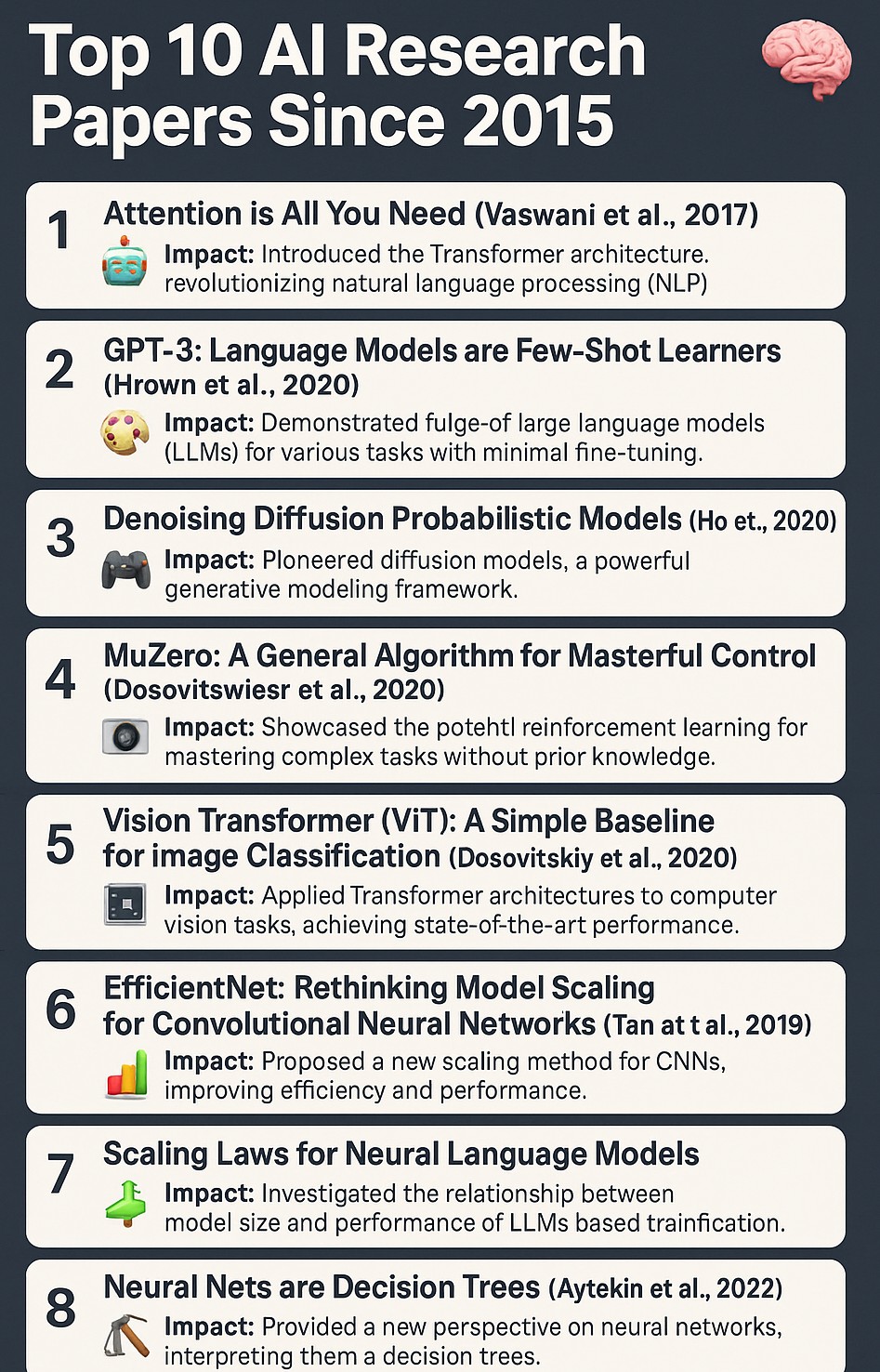Back
AI Engineer
AI Deep Explorer | f... • 8m
Top 10 AI Research Papers Since 2015 🧠 1. Attention Is All You Need (Vaswani et al., 2017) Impact: Introduced the Transformer architecture, revolutionizing natural language processing (NLP). Key contribution: Attention mechanism, enabling models to focus on relevant parts of input sequences. Link: https://lnkd.in/g7kvKktJ 2. GPT-3: Language Models are Few-Shot Learners (Brown et al., 2020) Impact: Demonstrated the capabilities of large language models (LLMs) for various tasks with minimal fine-tuning. Key contribution: Introduced GPT-3, a massive LLM with impressive few-shot learning abilities. 3. Denoising Diffusion Probabilistic Models (Ho et al., 2020) Impact: Pioneered diffusion models, a powerful generative modeling framework. Key contribution: Introduced a novel approach to generative modeling based on diffusion processes. 4. MuZero: A General Algorithm for Masterful Control (Schrittwieser et al., 2020) Impact: Showcased the potential of reinforcement learning for mastering complex tasks without prior knowledge. Key contribution: Introduced MuZero, a general-purpose algorithm that can learn to play various games at a superhuman level. 5. Vision Transformer (ViT): A Simple Baseline for Image Classification (Dosovitskiy et al., 2020) Impact: Applied Transformer architectures to computer vision tasks, achieving state-of-the-art performance. Key contribution: Introduced ViT, a simple and effective Transformer-based model for image classification. 6. EfficientNet: Rethinking Model Scaling for Convolutional Neural Networks (Tan et al., 2019) Impact: Proposed a new scaling method for CNNs, improving efficiency and performance. Key contribution: Introduced EfficientNet, a family of CNNs with better performance-to-parameter ratios. 7. Scaling Laws for Neural Language Models (Kaplan et al., 2020) Impact: Investigated the relationship between model size and performance in LLMs. Key contribution: Discovered scaling laws that predict the performance of LLMs based on their size and training data. 8. Neural Nets are Decision Trees (Aytekin et al., 2022) Impact: Provided a new perspective on neural networks, interpreting them as decision trees. Key contribution: Enhanced our understanding of neural network behavior and interpretability. 9. On the Cross-Validation Bias Due to Unsupervised Preprocessing (Dwork et al., 2015) Impact: Highlighted the importance of addressing bias in machine learning pipelines. Key contribution: Analyzed the bias introduced by unsupervised preprocessing steps and provided mitigation strategies. 10. LoRA: Low-Rank Adaptation of Large Language Models (Hoffmann et al., 2022) Impact: Introduced an efficient method for fine-tuning LLMs on limited resources. Key contribution: Proposed LoRA, a technique that reduces the number of parameters to be updated during fine-tuning.

Replies (1)
More like this
Recommendations from Medial
Himanshu Dodani
Start now what you j... • 9m
India's Al Leaders: Building Smart Language & Automation Solutions : - 1. Krutrim: Founded in 2022, it focuses on developing an India-specific LLM for 10 languages and became India's first pure-play Al unicorn. 2. Sarvam Al: Launched in 2023 by Al4
See More
Muttu Havalagi
🎥-🎵-🏏-⚽ "You'll N... • 1y
Al's understanding of reality is superficial: Al 'godfather' Yann Meta Chief Al Scientist Yann LeCun, considered as a godfather of Al, said Al's understanding of reality is "very superficial". "We're easily fooled into thinking [Al systems] are inte
See More
Abdul Shaikh
Every Dream is Worth... • 9m
🚫 Al Agents Are Coming-90% Will Fail Without This Key Factor Al agents promise seamless automation and intelligent decision-making, but their effectiveness hinges on one crucial factor: high-quality data. Without clean, structured, and accessible
See MoreAI Engineer
AI Deep Explorer | f... • 8m
Want to learn AI the right way in 2025? Don’t just take courses. Don’t just build toy projects. Look at what’s actually being used in the real world. The most practical way to really learn AI today is to follow the models that are shaping the indus
See MoreMuttu Havalagi
🎥-🎵-🏏-⚽ "You'll N... • 1y
Soon, Siri will be able to understand how applications work Siri, introduced with the iPhone 4S in 2011, marked the first encounter with Al for many 90s kids. Over the years, while Al evolved, Siri remained relatively static. However, Apple's work on
See More
AI Engineer
AI Deep Explorer | f... • 8m
My Favorite AI & ML Books That Shaped My Learning Over the years, I’ve read tons of books in AI, ML, and LLMs — but these are the ones that stuck with me the most. Each book on this list taught me something new about building, scaling, and underst
See MoreDownload the medial app to read full posts, comements and news.

































